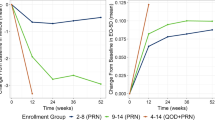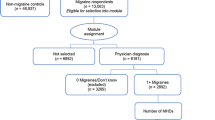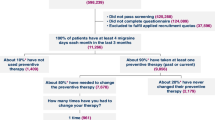Abstract
This study aims to evaluate health state utilities for migraine based on attack frequency from a mixed population sample consisting of migraineurs and non-migraineurs. A cross-sectional questionnaire survey was designed to measure health-related quality of life (HRQOL) in migraine without aura by time trade-off method (TTO). A convenience sample of university students and staff was recruited regardless of having ever experienced migraine or not. Subjects were asked to elicit two hypothetical health states characterised by different migraine frequencies (‘m’: two migraines lasting 4 h each month and ‘w’: each week) within two hypothetical lifetime frames (20 years left to live/lives until the age of 80 years). Utilities were calculated for the four tasks (U20m, U80m, U20w, U20w) and compared amongst subgroups. Overall 180 respondents were included in the analysis. Mean age was 25.6 years (SD 6.4), 128 (71 %) were female and 110 (61 %) were self-reported migraineurs. Mean utilities for two migraines each month were U20m = 0.84 (SD 0.26) and U80m = 0.89 (SD 0.14), and for each week were U20w = 0.79 (SD 0.27) and U80w = 0.83 (SD 0.17), respectively. Self-reported migraineurs and females attached higher mean utilities for U80m and older respondents for U20m, respectively (p < 0.05). To our knowledge, this is the first study that provides HRQOL results measured by TTO methodology for migraine. Utility loss ranged from 0.1 to 0.2 depending on attack frequency. HRQOL impairment of having two migraine attacks per week was found similar to living with low back pain (0.77–0.79).
Similar content being viewed by others


References
The international classification of headache disorders, 3rd edition (beta version) (2013) Cephalalgia 33(9):629–808. doi:10.1177/0333102413485658
Freitag FG (2007) The cycle of migraine: patients’ quality of life during and between migraine attacks. Clin Ther 29(5):939–949. doi:10.1016/j.clinthera.2007.05.008
Stovner LJ, Andree C (2010) Prevalence of headache in Europe: a review for the Eurolight project. J Headache Pain 11(4):289–299. doi:10.1007/s10194-010-0217-0
Bank J, Marton S (2000) Hungarian migraine epidemiology. Headache 40(2):164–169
Linde M, Gustavsson A, Stovner LJ, Steiner TJ, Barre J, Katsarava Z, Lainez JM, Lampl C, Lanteri-Minet M, Rastenyte D, Ruiz de la Torre E, Tassorelli C, Andree C (2012) The cost of headache disorders in Europe: the Eurolight project. Eur J Neurol 19(5):703–711. doi:10.1111/j.1468-1331.2011.03612.x
Weinstein MC, Torrance G, McGuire A (2009) QALYs: the basics. Value Health 12(Suppl 1):S5–S9. doi:10.1111/j.1524-4733.2009.00515.x
Torrance GW (1987) Utility approach to measuring health-related quality of life. J Chronic Dis 40(6):593–603
Stafford MR, Hareendran A, Ng-Mak DS, Insinga RP, Xu R, Stull DE (2012) EQ-5D-derived utility values for different levels of migraine severity from a UK sample of migraineurs. Health Qual Life Outcomes 10:65. doi:10.1186/1477-7525-10-65
Xu R, Insinga RP, Golden W, Hu XH (2011) EuroQol (EQ-5D) health utility scores for patients with migraine. Qual Life Res 20(4):601–608. doi:10.1007/s11136-010-9783-5
Brown JS, Neumann PJ, Papadopoulos G, Ruoff G, Diamond M, Menzin J (2008) Migraine frequency and health utilities: findings from a multisite survey. Value Health 11(2):315–321. doi:10.1111/j.1524-4733.2007.00246.x
Stalmeier PFM, Wakker PP, Bezembinder TGG (1997) Preference reversals: violations of unidimensional procedure invariance. J Exp Psychol 23(4):1196–1205
Stalmeier PF, Chapman GB, de Boer AG, van Lanschot JJ (2001) A fallacy of the multiplicative QALY model for low-quality weights in students and patients judging hypothetical health states. Int J Technol Assess Health Care 17(4):488–496
Stalmeier PF, Verheijen AL (2013) Maximal endurable time states and the standard gamble: more preference reversals. Eur J Health Econ 14(6):971–977. doi:10.1007/s10198-012-0445-0
Torrance GW (1986) Measurement of health state utilities for economic appraisal. J Health Econ 5(1):1–30
Stalmeier PF, Goldstein MK, Holmes AM, Lenert L, Miyamoto J, Stiggelbout AM, Torrance GW, Tsevat J (2001) What should be reported in a methods section on utility assessment? Med Decis Making 21(3):200–207
Gesztelyi G, Bereczki D (2004) Primary headaches in an outpatient neurology headache clinic in East Hungary. Eur J Neurol 11(6):389–395. doi:10.1111/j.1468-1331.2004.00800.x
Manhalter N, Bozsik G, Palasti A, Csepany E, Ertsey C (2012) The validation of a new comprehensive headache-specific quality of life questionnaire. Cephalalgia 32(9):668–682. doi:10.1177/0333102412447702
D’Amico D, Tepper SJ (2008) Prophylaxis of migraine: general principles and patient acceptance. Neuropsychiatr Dis Treat 4(6):1155–1167
Shamliyan TA, Choi JY, Ramakrishnan R, Miller JB, Wang SY, Taylor FR, Kane RL (2013) Preventive pharmacologic treatments for episodic migraine in adults. J Gen Intern Med 28(9):1225–1237. doi:10.1007/s11606-013-2433-1
Hollingworth W, Deyo RA, Sullivan SD, Emerson SS, Gray DT, Jarvik JG (2002) The practicality and validity of directly elicited and SF-36 derived health state preferences in patients with low back pain. Health Econ 11(1):71–85
Attema AE, Brouwer WB (2010) The value of correcting values: influence and importance of correcting TTO scores for time preference. Value Health 13(8):879–884. doi:10.1111/j.1524-4733.2010.00773.x
Acknowledgments
Authors are grateful to Prof. Adam Oliver (London School of Economics, Department of Social Policy) for his assistance in designing the time trade-off questions, and to Dr. Peep F. M. Stalmeier (Radboud University Medical Centre, Nijmegen, Department of Epidemiology, Biostatistics and HTA) for his comments on the manuscript. We also thank Ida Urbán, undergraduate student (Corvinus University of Budapest) for her help in implementing the web-survey.
Author information
Authors and Affiliations
Corresponding author
Appendices
Appendix 1 Health state description of migraine
Migraine is an episodic but recurrent headache characterised by strong, pulsating typically unilateral pain, mostly in the frontal and eye region of the head. It is often associated with nausea, vomiting, and sensitivity to light or sound. Migraine attacks can lead to functional impairment and might affect daily activities (e.g. work). For 1–2 days after the migraine attack, patients may feel fatigue, daytime sleepiness, and difficulty in concentrating. On migraine-free days migraine sufferers often worry about when the next attack will strike.
Appendix 2 Survey questions
20-years question (Q20m/w)
Imagine that you suffer from migraines. You typically have two migraine attacks each month/each week and each one lasts for about 4 h. Imagine that you are expected to live for 20 more years with these migraines, after which you will die. There is a pill that you can take, which will relieve the migraines completely, but will also shorten your life. What is the minimum number of years of migraine-free life you would require if you were to take the pill?
80-years question (Q80m/w)
Imagine that you suffer from migraines. You typically have two migraine attacks each month/each week and each one lasts for about 4 h. Assume that you are at the age that you are in reality now, and that you are expected to live until you are 80 years old, suffering migraines as indicated above. How many of the years that you have left would you give up to be free of migraine?
‘m’ corresponds to two migraines each month and ‘w’ corresponds to two migraines each week.
Rights and permissions
About this article
Cite this article
Rencz, F., Brodszky, V., Péntek, M. et al. Health state utilities for migraine based on attack frequency: a time trade-off study. Neurol Sci 36, 197–202 (2015). https://doi.org/10.1007/s10072-014-1920-4
Received:
Accepted:
Published:
Issue Date:
DOI: https://doi.org/10.1007/s10072-014-1920-4


